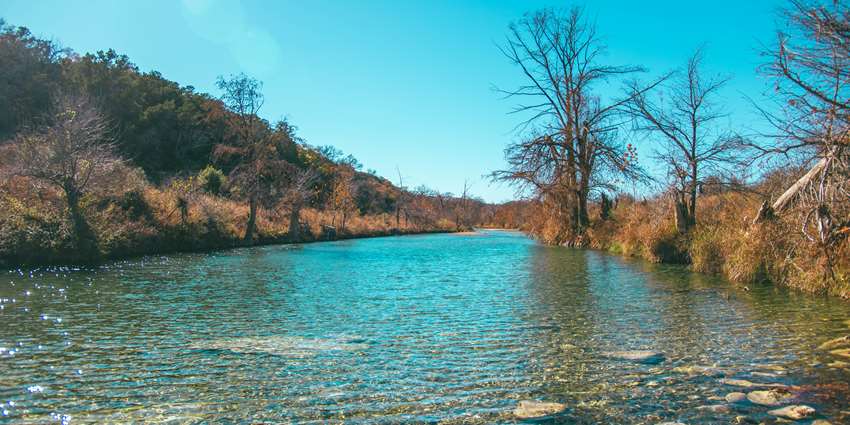The Blanco River, near Wimberley. (By Chantal Cough-Schulze)
Peer-reviewed publications by TWRI and Texas A&M AgriLife scientists
Classification of watersheds in the conterminous United States using shape-based time-series clustering and Random Forests: Co-authored by Luna Yang, Texas Water Resources Institute research specialist, this paper proposes a watershed classification method using shape-based time-series clustering techniques to define hydrologically homogeneous classes for a set of 638 gauged watersheds in the U.S.
Microplastics removal in the aquatic environment via fungal pelletization: The issue of microplastics (MPs) is rising in not only numbers but also in increased recognition of the damage they cause to ecosystems. Coauthored by Susie Dai, Ph.D., associate professor in the Department of Plant Pathology and Microbiology, College of Agriculture and Life Sciences at Texas A&M University, this study proves the damage done by MPs can be reversed to a degree and shows proven methods of prevention and minimalization of future pollution issues in water.
Evaluation of surface drip irrigation systems focusing on water-use efficiency in high-value vegetable production in the semi-arid, windy region of the Texas High Plains: A study coauthored by James Gray, Ph.D., West Texas A&M University, and Texas A&M AgriLife Research and Extension Center at Amarillo scientists Li Paetzold, Ph.D., Qingwu Xue, Ph.D., and Charles Rush, Ph.D., evaluated surface drip irrigation (SDI) systems in the High Plains of Texas and the sustainability of production crop irrigation from the Ogallala Aquifer. The study demonstrated feasible high-value vegetable production in the region using SDI.
Texas A&M AgriLife Extension Service study shows toxicant effective tool to reduce feral hog populations: John Tomeček, Ph.D., Department of Rangeland, Wildlife and Fisheries Management associate professor, and Michael Bodenchuk, director of Texas Wildlife Services, conducted a 2-year study on a toxicant for feral hog control in Texas. This study used a warfarin-based toxin, and results showed sharp declines in numbers and property damages when used correctly and consistently.
Water-related research and news from universities around Texas
Unprecedented historical erosion of US Gulf Coast: A consequence of accelerated sea-level rise?: The Gulf Coast is experiencing extraordinary amounts of erosion and land recession. Coauthored by a Rice University scientist, this study examined data from 13 sites across the Gulf Coast and found that these changes are attributed to the decrease of land migration or shoreline growth, which is likely due to the rise of the sea levels which are rapidly increasing each year.
Molecularly confined hydration in thermoresponsive hydrogels for efficient atmospheric water harvesting: University of Texas at Austin scientists have developed a hydrogel that turns hot air into clean, safe, drinking water. This gel would allow people in regions of the country and the world with limited available water to create water with a device. The researchers said the device forms water from the atmosphere using sunlight, quickly and safely.
Field surveying data of low-cost networked flood sensors in southeast Texas: Lamar University is spearheading a study that would help reduce flooding risk in Southeast Texas. They created a sensor network that measures “real-time water stage information.” This data will help in emergency situations with decisions that officials must make for the sake of public safety.
Drinking water quality and social vulnerability linkages at the system level in the United States: Co-authored by a Bureau of Economic Geology at UT Austin scientist, this study analyzed whether water quality issues disproportionately affect socially vulnerable communities. They examined relationships between health-based drinking water quality violations and social vulnerability using a new database of community water system service areas and a modified Social Vulnerability Index, which they specifically designed for drinking water quality.
Experimental instrumentation of water stage monitoring stations in mountain streams bedrock using pressure transducers: The installation of non-vented pressure transducers has been invasive and damaging to streams and rivers in mountain terrain. Co-authored by a Texas A&M University scientist, this study showed a new method of installation that uses copper casing inserted into bedrock. This version of installation reduces damage to rivers and streams and the pressure transducers from extreme floods and vandalism.


